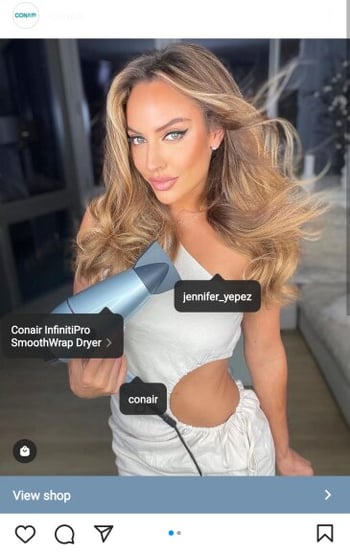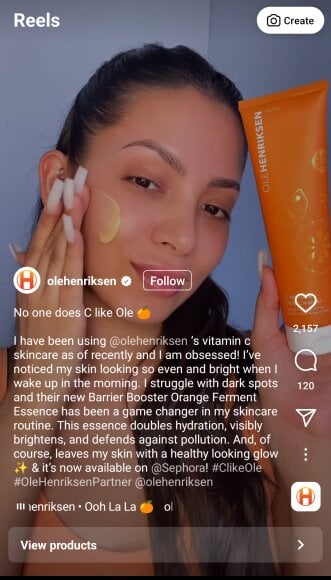8 Examples of Brands That Are Good at Product Seeding
Effective brand seeding is tough to execute but some brands truly nail their strategies! Here are eight examples of product seeding done right.
Instagram product tagging is now available to all businesses and creators. This post breaks down how tagging works and best practices for brands.
.jpg)
.jpeg?width=800&name=ig%20product%20tagging%20cover%20(1).jpeg)
While many changes to Instagram make businesses cringe, this is an update to celebrate.
As of April 2022, Instagram has expanded product tags (AKA shopping tags) to all business accounts in the United States. This includes creators!
Translation? Shoppers can now find and buy products tagged by anyone on Instagram.
This update is a big deal for creators and brands alike. More people posting their favorite products means more opportunities to build brand awareness.
If you’re new to product tagging on Instagram, we’ve got you covered! Below you’ll learn:
Product tagging is a feature that lets business accounts and creators on Instagram highlight products in their posts. This includes In-Feed, Reels, Stories and videos.
These tags are sourced from products in a business’ Instagram Shop. Tapping a product tag takes you to a purchasing page without leaving Instagram.
Let’s say you’re a beauty brand and a customer wants to show off their latest look. This new tagging update lets customers highlight products in their snapshots and selfies. In turn, their followers can see the products and buy directly from your Instagram Shop.

Source: @eg0friendly
In the Before Times™, Instagram product tagging in posts was only available to select brands and creators. Now it’s fair game for individual accounts whether they have 10 or 10,000 followers.
Here’s a quick run-through of how the process works for taggers and shoppers.
First, you (the brand or creator) tag a product in your content. When someone taps through your post, they’ll be able to see that there’s a shoppable item. This is denoted by the double rainbow arrows on the tag (see below).

Source: @harpercollins
If someone taps through, they’re taken to an Instagram product page. Here they’ll see the price tag, product details and related items they can buy from the same brand. Shoppers can either add the item to their cart or buy it outright.
Source: @harpercollins
This process is seamless and empowers people to buy without bouncing from Instagram. Think of it as a mini ecommerce experience housed entirely on the platform.
Not a fan of Instagram’s native checkout? Would you rather direct shoppers to a specific product page? No problem. Brands have the option to send traffic to their sites. In that case, the “Buy Now” option is replaced by “View on Website.”
Source: @perlierusa
If this new roll-out is primarily for creators, why should brands care?
Fair question!
For starters, this update means small and local businesses are more discoverable. Making shoppable tags more available levels the playing field for up-and-coming brands.
Consider how Instagram has become a hub of product discovery and research. The more of your products are out “in the wild,” the better. Consider the data from Instagram themselves about the power of shoppable posts:
While some people buy on impulse, many use Instagram as a shopping window. Now that access to product tagging has expanded, these Instagram shopping habits can transfer to creators using the feature.
Oh, and Instagram product tagging also streamlines the process of creator referrals. When shoppers see a creator tag your products, they can click directly on the product tag and buy it on Instagram.
That means not having to navigate your website and potentially drop off. This sort of direct attribution is super helpful for learning which creators are crushing it. Not to mention which of your products are most popular.
Now, let’s look at some examples of product tags in action.
Resharing user-generated content is a low-hanging way to use product tagging for brand awareness. Below is a shoppable post from Conair that shows hair stylist Jennifer Yepez using Conair’s SmoothWrap hairdryer.
The positive product review, social proof and shopping tag serve as a three-in-one combo to win over customers. Peek at all of those eager comments from followers!


Source: @conair
Will followers who see Jennifer’s post buy a SmoothWrap immediately? Maybe not.
That said, this post is a valuable touchpoint if someone was on the fence.
This post plants the seed for a future purchase. It could also deter shoppers from seeking a similar, competing product. The post above is a perfect example of nurturing customers through the modern, non-linear buyer’s journey.
Product tagging is also an effective way to show your audience how to use an item. This is especially true for products that require multiple steps.
For example, skincare kits! Check out the Reel below from Ole Henriksen. The post features a review from a creator who walks viewers through how to apply the products in their new Vitamin C skincare line. Note how the creator also goes out of her way to explain the benefit of each product.

Source: @olehenriksen
Since Ole Henriksen is partnering with Sephora for this campaign, the creator directs viewers to buy the products there. Shoppers can also purchase the new line right off the post when they click “View Products.” This highlights how brands can use Instagram Reels to drive sales with creators.
Another good way to use shoppable tags is to show off creative uses for your product. The post below from Marley’s Monsters illustrates how the brand’s reusable paper towels can be repurposed for various needs.
.jpg?width=350&name=Marleys%20Monsters%20Example%20Product%20Tagging%20(1).jpg)
Source: @marleysmonsters
Instead of just posting a picture of the reusable paper towel roll itself, the photo showcases the product in a real-world setting. This highlights how creators can take otherwise “static” products and bring them to life.
Before you can start getting your products tagged by creators, you’ll first need to make an Instagram Shop and be approved by the platform.
We have an entire post breaking down how to set up an Instagram shop if you haven’t already. Either way, here’s the short of it:
If your brand is collaborating with creators, you can ask them to tag your products in their content directly.
But first, you’ll need to give them access to your product catalog. Here are the steps as outlined by Later:
Source: Later Blog
Note: You can also suggest products for creators to tag. These will appear at the top of their product list when tagging a post. To do this, go to the creator account and click “Suggest Products.”
You can view the performance of posts your products are tagged in by clicking “View Insights” on an approved creator’s post. Analytics like impressions and reach will pop up so you can measure the effectiveness of each post against your campaign goals.
If you want to direct creators to tag your products, the process is pretty straightforward. Chances are they’ll know what to do but below we’ve recapped the whole process.
Step 1: Start by creating a post as you normally would. For this example, we’re going to tag a brand in an In-Feed Post.
Step 2: Upload your photo and edit it as you normally would with your captions, filters and so on. Once it’s good to go, tap “Tag people” under the photo caption.
Step 3. Tap your product in the photo to place a tag. You’ll then be prompted to search for “who” is in the picture. Simply search the brand’s account name and select it. The brand’s tag should appear on your photo. Then, you’ll see a prompt on the bottom right-hand corner to tag products.
Step 4: Search for the name of the product you’re tagging. Once you find it, tap “Done.”
Step 5: Review your product tag and make sure it’s placed where you want it. If you’re happy, click the blue checkmark and publish.
And that’s that!
Note: To add product tags to Stories, use the “Stickers” icon and choose the “Product” link sticker. Select the product you want to add and then publish it as normal. For Reels, create your post as normal and tap “Tag Products” prior to publishing. Choose from the products or collections you want to include, then publish.
To wrap things up, here are some quick tips for making the most of product tags:
Source: @darklingbeloved
Source: @curlsmith_official
 Need Creators To Tag Your Products on Instagram? We Can Help!
Need Creators To Tag Your Products on Instagram? We Can Help!Product tagging is a powerful tool for building brand awareness and driving sales.
This is especially true now that creators can give your products a boost, too.
Because creators know best when it comes to publishing content that drives engagement and attracts your target audience. The more relevant your product is to a creator’s interests, the more authentic that shoppable post will be.
That said, reaching out to those creators for brand partnerships takes a lot of time and effort. It’s tough to find creators that match your brand’s audience, too.
That’s where Statusphere comes in. Our full-service creator platform handles everything from matchmaking to getting your products in their hands.
Want to see how the process works? Chat with one of our consumer-to-consumer marketing specialists today and learn how we can get creators posting about your brand.
Effective brand seeding is tough to execute but some brands truly nail their strategies! Here are eight examples of product seeding done right.
Product seeding programs featuring influencers can build awareness at scale. Below we dig into popular types of PR seeding campaigns for product...
Influencer product seeding is super effective if you have the right strategy. We explain why and how influencer seeding works and steps to improve...
Be the first to know about the latest tools, trends and strategies in influencer marketing for brands.